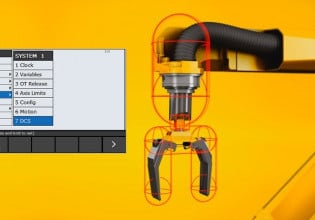From Factory Floor to Operating Room: Control Technology Advances in Surgical Robotics
Manufacturers and suppliers of control components have continually developed technology for industrial use, and now these innovations are stretching beyond industrial environments.
Automation suppliers and manufacturers have taken part in the continued development of various robotic applications in the last several years. Robotics and motion control supplier, EU Automation, has seen a growing demand for sensors and other control components placed on the end arm tools of a robot.
EU Automation Making Headway in Sensor Development
Force sensing resistors, or FSRs, see a change in resistance depending on the force placed on them, giving a variable voltage reading that can be read as a change in force. For surgery, FSRs have to be small enough to securely fit on robotic end pieces without contributing too much to their overall form factor.
They also must be sensitive enough to relay accurate real-time haptic feedback to surgeons so they can feel operations inside the body. Thanks to increased demand, years of developments in sensor manufacturing have led to FSRs that can meet these critical specs.
“Developing small sensors was a challenge for the manufacturing industry,” says Claudia Jarrett, country manager at EU Automation. Soft robotic surgical systems need to be small and the sensors that sit on the system’s robotic fingertips need to be even smaller for procedures to be safe.”
Innovations in HMI Technologies
In addition, there have been developments in HMI’s that enable processing of normalized readings of forces applied by effectors inside the body. EU Automation cites a human-machine interface called NEO, that uses sensors to relay the pressure applied by a grasper end piece inside the body. The surgeon wears the HMI device on their body to apply force to the grasper and see and feel a pressure reading based on the applied force.
Meanwhile, another company discusses how force sensing over a large sensor area can enable location-based force sensing on robotic skin. It cites how FSRs can be used to enable proprioception (awareness of relative motion in relation to one’s self) and kinesthesis (awareness of interaction and impact with the ground and objects in one’s environment) in robots for useful opportunities in several industries outside of medicine.

Robotic force-sensing technology using a FANUC robot. Image courtesy of FANUC.
“With the size of the integrated sensor so small, the device can provide a range of tactile sensation without increasing the size of the instrument in use. Therefore, going forward, sensors can be produced in a variety of shapes and sizes to meet a wide range of design requirements, ” says Jarrett of the Neo haptic interface.
Motion Control Contributing to Sensor Development
The overall rise in robotic-assisted surgery is also thanks to wider distribution of motion control solutions like motors, encoders and drives, and for tremor correction. Developments in small-signal processing have enabled novelty HMIs with operations felt by the surgeon through haptic feedback sensors on the robotic end pieces.

Robot and end of arm tools being used with robotic sensors in the operating room with an HMI. Image courtesy of Forbes.
In addition, developments in robotics have led to upward trends across multiple markets and technology sectors.
In the case of ultra-thin FSRs, robots that can perform delicate operations on diverse, soft, or breakable materials will bring value to companies for operations like sorting, assembly, and pick and place. Haptic robots have increased precision in the food industry and in the supply chains of other consumer goods as well.
FSRs on end effectors can grant robots kinesthesis to detect delicate motions of touch. This can enable them to handle and classify diverse items and packages, making them useful in operations like packaging.
Teleoperated control by haptic feedback can also make robots more useful in research and development fields in clean rooms and in other sensitive environments. This technology may also help robots to be better equipped for working alongside people, preventing unsafe impact and harmful twisting or indelicacy of touch.
Where do you see the future of surgical technology in robotics? Do you think this specific kind of sensor technology will be used in the industrial sector in the future?
About EU Automation: EU Automation serves many markets requiring retrofit robotics solutions, including the Aerospace, oil and gas, and food and beverage industries.






